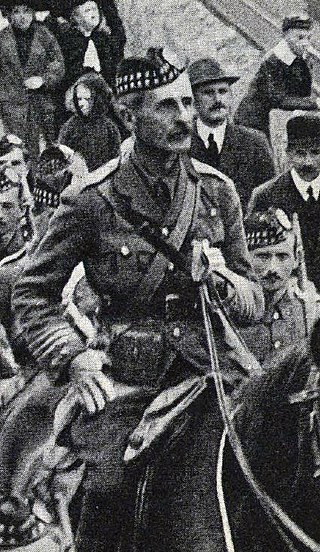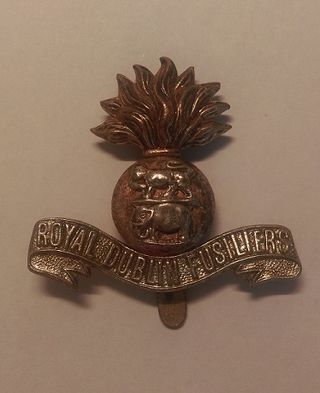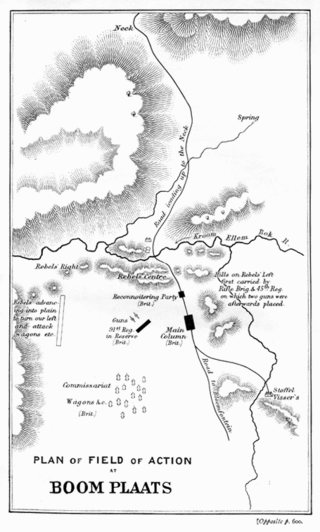
The Second Boer War, also known as the Boer War, Transvaal War, Anglo–Boer War, or South African War, was a conflict fought between the British Empire and the two Boer republics over the Empire's influence in Southern Africa.

Colonel William Eagleson Gordon, VC, CBE was a Scottish British Army officer and recipient of the Victoria Cross, the highest and most prestigious award for gallantry in the face of the enemy that can be awarded to British and Commonwealth forces. He is the older brother of Archibald Alexander Gordon, who received the Legion of Honour and Order of Leopold.

Brigadier Lewis Pugh Evans, was a British Army officer and a recipient of the Victoria Cross, the highest award for gallantry in the face of the enemy that can be awarded to British and Commonwealth forces.

Brigadier-General Francis Aylmer Maxwell, was a British Army officer in the Second Boer War and First World War. He was also a recipient of the Victoria Cross (VC), the highest award for gallantry in the face of the enemy that can be awarded to British and Commonwealth forces.

The Royal Dublin Fusiliers was an infantry regiment of the British Army created in 1881 and disbanded in 1922. It was one of eight 'Irish' regiments of the army which were raised and garrisoned in Ireland, with the regiment's home depot being located in Naas. The regiment was created via the amalgamation of the Royal Bombay Fusiliers and Royal Madras Fusiliers, two army regiments stationed in India, with militia units from Dublin and Kildare as part of the Childers Reforms. Both battalions of the regiment served in the Second Boer War.

The Battle of Paardeberg or Perdeberg was a major battle during the Second Anglo-Boer War. It was fought near Paardeberg Drift on the banks of the Modder River in the Orange Free State near Kimberley.

The Battle of Boomplaats was fought near Jagersfontein at 29°50′53.47″S25°38′56.54″E on 29 August 1848 between the British and the Voortrekkers. The British were led by Sir Harry Smith, while the Boers were led by Andries Pretorius. The British were victorious after one Boer opened fire too early and betrayed their position.
The Battle of Sanna's Post was an engagement fought during the Second Boer War (1899–1902) between the British Empire and the Boers of the two independent republics of the Orange Free State and the South African Republic.
The 14th Infantry Brigade was a British Army formation during the Second Boer War, World War I, when it served on the Western Front, and World War II, when it fought in Crete and Tobruk, and then as Chindits in Burma.

The Great Boer War is a non-fiction work on the Boer War by Arthur Conan Doyle and first published in 1900 by Smith, Elder & Co. By the end of the war in 1902 the book had been published in 16 editions, constantly revised by Doyle. The Introduction describes the book as:
A very thorough account, including tables at the end of those killed or wounded up until the 8th September when he left South Africa. This account is compiled with as much accuracy as was attainable at this date, and with as much detail as a single volume will permit. In frequent conversations with Boers, Conan Doyle has endeavoured to get their views upon both political and military questions. Often the only documents he had to consult were the convalescent officers and men under his care, therefore some errors may have crept in. The closing scenes of the Boer War have necessarily been treated with less detail than the earlier.
Brigadier-General Arthur Henry Seton Hart-Synnot, (1870–1942) was a British Army general who saw service in the South African War; then in Japan, Hong Kong, Burma, and India; and finally in France in the First World War.

The siege of Kimberley took place during the Second Boer War at Kimberley, Cape Colony, when Boer forces from the Orange Free State and the Transvaal besieged the diamond mining town. The Boers moved quickly to try to capture the area when war broke out between the British and the two Boer republics in October 1899. The town was ill-prepared, but the defenders organised an energetic and effective improvised defence that was able to prevent it from being taken.
Marshall's Horse was a South African cavalry unit formed in 1899 at the start of the Second Boer War to provide military support for the British campaign. The unit was created from the Uitenhage Rifles and 1st City (Grahamstown) Volunteers. They formed in Grahamstown, initially comprising 244 members before rising to 500 in late 1899. The unit's first commanding officer was Major George Marshall CMG.

The Battle of Poplar Grove was an incident on 7 March 1900 during the Second Boer War in South Africa. It followed on from the Relief of Kimberley as the British Army moved to take the Boer capital of Bloemfontein. The Boers were demoralised following the surrender of Piet Cronjé at the Battle of Paardeberg. General Sir John French's cavalry attacked the Boer force from the rear while mounted infantry and horse artillery attacked from the right flank. The Boers abandoned their positions in panic before the cavalry. The commander-in-chief of the Free State forces, Christiaan de Wet, in his book called the chapter on the subject "Wild Flight from Poplar Grove". This battle was followed by the Battle of Driefontein on March 10, 1900.

The military history of Australia during the Boer War is complex, and includes a period of history in which the six formerly autonomous British Australian colonies federated to become the Commonwealth of Australia. At the outbreak of the Second Boer War, each of these separate colonies maintained their own, independent military forces, but by the cessation of hostilities, these six armies had come under a centralised command to form the Australian Army.
21st Brigade was an infantry formation of the British Army first organised in the Second Boer War, when it took part in Ian Hamilton's March from Bloemfontein to Pretoria. Reformed in World War I it served under the command of first 7th Division and then 30th Division, fighting in most of the major battles on the Western Front from the First Battle of Ypres to the Armistice. It was briefly re-raised in the Sudan early in World War II before being transferred to the Indian Army.
The 1st Australian Horse was a mounted infantry regiment of the Colony of New South Wales that was formed in 1897. The 1st Australian Horse wore distinctive myrtle green uniforms with black embroidery.
Colonel Sir George Murray Home Stirling, 9th Baronet CBE DSO was a Scottish British Army officer who was Lord Lieutenant of Stirlingshire from 1936 until 1949.

The South Australian Mounted Rifles (SAMR) was a mounted infantry unit of the Colony of South Australia that served in the Second Boer War. The first contingent of South Australian Mounted Rifles was raised in 1899, followed by a second contingent in 1900.












